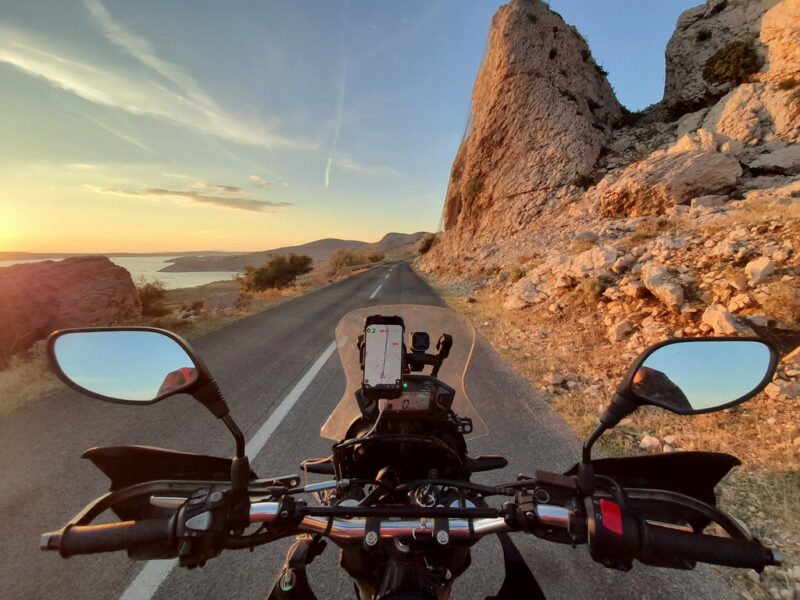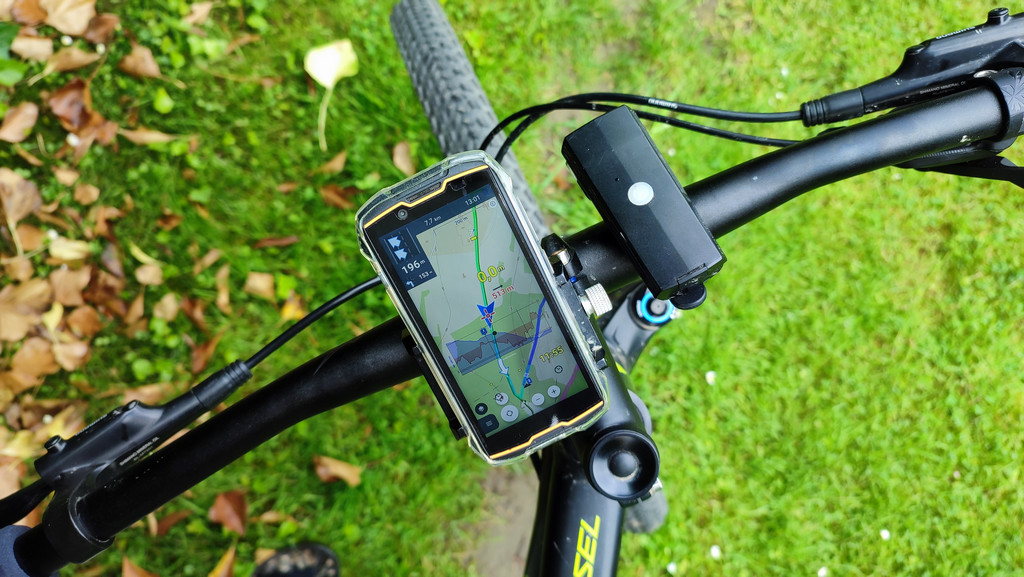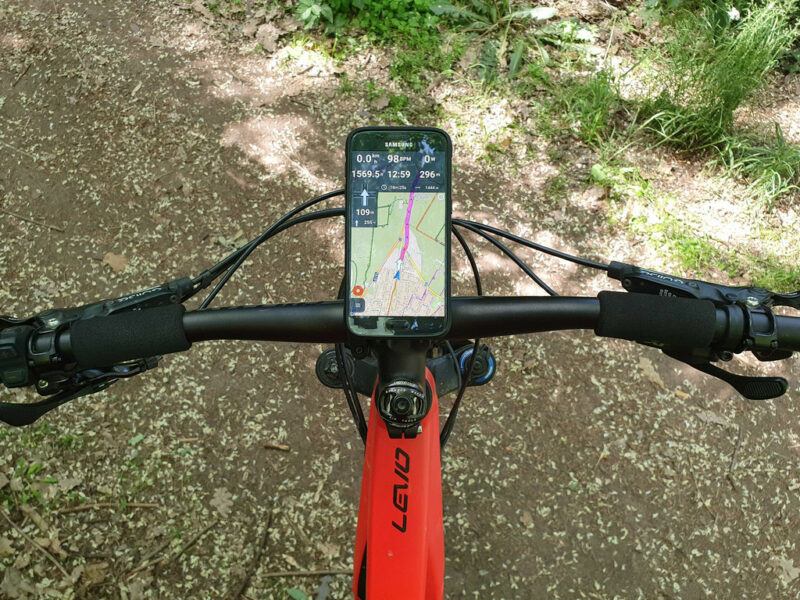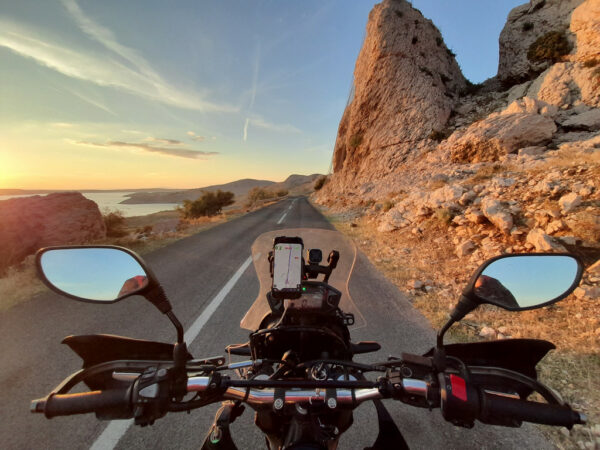We hear this question quite often on the Locus forum, on the helpdesk, and on social media. What parameters should it have? What memory, battery life, processor? Primarily we are trying to get Locus to run on almost anything as we don’t have much insight into the available hardware. We only use a few dozen common devices in development and for normal operation.
However, let’s try to design an ideal model that would meet all available criteria for use with Locus. So what features should it have?
Durability
Locus Map is primarily designed for use as a navigation device for outdoor activities – hiking, mountain biking, climbing mountains, or scrambling through thickets for geocaches. So the phone should be able to withstand something – it should be shockproof and reasonably waterproof to survive a fall into mud or a cloudburst without harm. Some phones are directly certified for higher durability, and you can identify by this certification what the phone should be able to handle without harm.
But there are also plenty of cases and covers on the market that can turn your lounge model into a serious outdoor brick.

High-quality display
The basic communication interface of Locus is the map. If it’s illegible or not visible in direct sunlight, it won’t be much help in orientation. We, therefore, recommend choosing models with higher resolution, contrast, and, most importantly, display brightness. This is given in units of Nits or cd/m2. Many manufacturers mention this figure for their models, or it is measured independently by some reviewers, such as Gsmarena.com. Remember that many phones can only use the maximum display brightness if the brightness is set to auto. Of course, development is coming in leaps and bounds in this area – try comparing, for example, the very high-quality display on the Samsung S10 with the latest S22, the difference is very noticeable.
Large battery capacity
In general, the display, GPS module, and processor consume the most power. Locus Map uses all of them – the display shows the map, routes, and caches, GPS and other motion sensors capture your location, vector maps, and geodata work occupy the processor. So it’s understandable that the app takes a proper bite out of your battery when running at full speed. Therefore, we recommend getting a phone with a bigger battery or carrying a power bank with you on longer trips.
Battery capacity is measured in mAh and this figure is always given by the manufacturers in the specifications of the phone. Higher = better, but the overall battery life also depends on other aspects such as manufacturer optimization. So again, it’s a good idea to follow reviewers who have an established methodology for testing phone endurance so they can compare models against each other.
However, Locus Map can also save the power – the display can be automatically switched on only before turns during navigation, while the GPS saver mode records the location only after a few minutes. If you turn on the “airplane” mode, an average phone can run with Locus for a whole day.
Compact size
A smaller phone is less prone to damage, fits better on the handlebar of a bike, and a smaller display “eats” less… The smaller size has undeniably many advantages, unfortunately, current trends do not favor small mobile phones. Shops are full of giant “pancakes” with six-inch displays that don’t even fit in your pocket. And let’s face it, we got used to large displays very quickly, they are easy to read, they can fit a lot of information, they are great for viewing photos and videos… On the other hand, a smaller phone overwhelmingly means a smaller battery, see the previous section. So everyone has to find the right compromise.
Getting a second smaller phone can be an acceptable solution, or you can fish an older model out of the drawer. You don’t even need to have a SIM card on it, Locus can run offline.

High-quality sensors
Every smartphone gathers information about the world around it using a range of built-in sensors. Of course, a high-quality GNSS module (GNSS = Global Navigation Satellite System) is indispensable for Locus Map, which can receive data not only from the GPS network but also from other systems – Galileo, Glonass, or China’s Beidou. The more satellites it locates, the more accurate the position it sends to Locus. Modern phones of recent years can further improve position accuracy significantly by using multi-band GNSS. This is useful, for example, for navigation in cities, where there is significantly less variation in the reflection of the satellite signal from buildings.
For orientation within cardinal directions, it is a good idea to have a hardware magnetic compass (Locus works without it too, but then it only calculates orientation when moving from GPS data). But don’t forget to calibrate it occasionally.
Locus also gets altitude information from GPS, but this can be greatly improved if the phone also has a barometric altimeter. However, its use needs to be activated in the Locus settings.
A good quality proximity sensor is useful for the proper operation of controlling the screen by gestures, but that’s just icing on the cake.
Connectivity
Locus Map can communicate with many external sensors – heart rate, speed, cadence and power sensors, thermometers, etc. Both Bluetooth and ANT+ are supported. Bluetooth is a standard feature of all smartphones. It’s worse with ANT+, which is unfortunately on the way out of the technological limelight. Manufacturers often no longer even indicate in the specifications of individual models whether ANT is installed, so we can only rely on the list of officially supported devices on the website www.thisisant.com. It has to be said that the list is unfortunately not expanding much anymore. Fortunately, more and more sensors supporting the latest Bluetooth standards are becoming available.
However, if you don’t actively collect data about your sports performance and are just outdoors for fun, you can safely skip this parameter.
Performance
You can run Locus Map even on an older Android 5 phone (the oldest supported operating system), but let’s face it, it’s a bit more fun on the latest octa-core with 16 GB of RAM – you can view dozens of routes and thousands of caches on the map without lagging, use map overlays conveniently, or import large KMZ files. But if you learn to save power wisely, Locus Map doesn’t require any extra “cannon”.
You can save yourself a lot of trouble if you choose a model with a “clean” version of the Android operating system. Various add-ons, especially from Chinese manufacturers, often include battery-saving software that, at the best settings, turns off Locus Map when you need it the least – when recording a track or navigating.
What phones do we use?
We did a little research in the team: the developer part prefers models with pure Android, i.e. Pixels of all possible generations from the archaic Pixel 1 to Pixel 5, and there would be some Nokia ones too. The support section has Chinese phones Xiaomi, Honor, and OnePlus, as these cause the most problems that need to be tested frequently. We carry small or older phones on the bike – for example, the miniature and durable Cubot KingKong Mini 2 or, among the older ones, the legendary aluminum HTC One Mini 2 or Samsung S7. But some of our users go much further in their experiments. 🙂

As part of a responsible approach to the environment, it’s best to simply use the phone you already have, or for fun in the field, pull out an old, no longer used one from the drawer. So just think of this article as a set of recommendations on which features of your hardware to monitor.




39 Comments
Samsung A52 is super. Waterresistent and large batterij. 8 ours biking with phone at airplane setting and locus continue on. At the end of the trip the batterij was 50%
Best mobile for locus is with full battery.. ;)
Ich benutze Blackview Handys. Auch chinesisch aber funktioniert sehr gut. Meine zwei Blackview s sind Das BV6600 pro mit Wärmebild und BV9100pro. Laufzeit 30/60 Tage. Perfekt für Locus.
Ich benutze immer mein normales aktuelles Smartphone. Von Samsung S3 über S7 bis zum augenblicklich genutzten S10 lite. Für lange Touren habe ich selbstverständlich immer eine Powerbank mit 10.000 mAh mit dabei. Wobei das S10 lite schon einen recht großen Akku hat, der auch 8-9 h durchhält.
Ano, ideální je mít telefony dva. Jeden v kapse na volání, focení a tak. No a druhý s Locusem mám na řídítkách na motorce. Konkrétně mám už asi třetí Xiaomi. Proč tuhle značku ? Baterie vydrží bez dobíjení celý den jízdy a nemusím tahat žádné kabely. A to mám stále zapnutý displej a záznam trasy. Na Samsungu a Huawei Locus také jede parádně, ale ta baterie...
I'm using an Blackview BV9500pro with a 10.000 mAh battery. It's old but the battery capacity keeps me happy for days! The shock proof body can be clamped on the steering bar of every bike.
Nokia XR20 is excellent
Doogee V 20
Yepp, the battery runtime of 2-3 days is a bit small, but the display is very bright.
I use a CAT S41, and couldn't be happier!
Pixel 5 is (or was for me) perfect for outdoor activities with Locus Map. I'm currently on Pixel 6 Pro and it's great but a little bit large - awesome for planning and showing a route to other people, but not so handy while hiking.
Huawei p30 pro, halt im Flugmodus aktuell ca. 2Tage Tracking und Karten anzeigen durch.
Ziemlich wasserfest und ausreichend robust.
Bin seit einiger Zeit ohne LocusMap: Mein Premium-Account ist ausgelaufen. Und da ich inzwischen ein Google-freies Android-Smartphone mit /e/OS verwende, kann ich es mangels PlayStore nicht mehr verlängern. Zudem stören mich die zahlreichen Tracker in der App, die ich in einer Bezahl-App fehlplatziert finde.
Welches Navigationssystem passt nun zu deinem neuen Betriebssystem? Gruß
Ich habe mir ein catphone s61 extra für locus zugelegt. Bin seit Jahren sehr zufrieden aber langsam wird es auch etwas langsamer. Es ist genial für den harten Geocaching Einsatz und der große Akku ist mega.
Samsunggeräte scheiden aus, da sie die Helligkeit zwangsweise dimmen und so LM 4 unbrauchbar machen (s. Auch Beiträge im Forum).
Ich benutze jetzt das Oppo Find X2 pro. Ein besser ablesbares Display habe ich noch nicht gesehen.
Wo kommen die märchenhaften Akku-Laufzeiten in diesen Beiträgen her? Ich teste immer die Laufzeit bei voller Helligkeit und eingeschaltetem GPS. Da kommen die aktuellen Handys allesamt auf max. 4 Stunden Laufzeit. Da ich eine Powerbank nutze ist das auch kein Problem. Die genannten Laufzeiten sind doch nur zu erreichen, wenn das Display immer wieder ausgeschaltet wird, oder?
We've used Locus Classic and 4 on 3 brands of phones and our current OnePlus 8pro and 8T stand out above all.
Xiaomi POCO 3 Pro (256GB)
Leistungsstark und günstig (Black Friday Amazonangebot 2021 für 199€)!
Immer mit dabei (IP53) in einer Schutzhülle. Das Ganze in einem kleinen Gürteltäschchen.
Im Urlaub (wenn ich mehrere Tage nicht an einer Steckdose bin) sind zusätzlich natürlich noch mehrere große Powerbanks zum abends Nachladen mit dabei.
Mein Locus Maps läuft auf einem Fairphone 3+. Für die Anwendung ideal:
Großer Akku, der reicht für normale Touren dicke uas. Der Akku ist wechselbar und wenn der erste wirklich mal leer ist - einfach den frischen rein und weiter.
Die Displaygröße finde ich gut am Lenker, größer muss es nicht sein. Die restlichen Parameter passen auch.
For me, IS it Xiaomi redmi note 10 pro.
Ich habe ein samsung s20 fe, läuft mit locus classic 3.5 super, bin voll zufrieden, akku reicht einen vollen Wandertag. Habe auch locus 4.0 gold, da stimmen leider die Höhenmeter überhaupt nicht, schade deswegen bleibe ich im Moment beim alten Locus weil da die Höhenmeter bei 4.0 ziemlich zuverlässig aufgezeichnet werden. Aber generell ist für mich Locus eine der wichtigsten und besten Apps auf meinem Handy
Hello,
Locus Map processes elevation gain from the data it receives from your phone GPS. If the data are incorrect or contain huge deviations, then the resulting elevation gain is also incorrect. Locus Map, however, offers a few methods on how to limit these deviations.
Open Locus settings > GPS&sensors:
Location filter > select medium or heavier filter
Google Services assisted location > turn it ON
Altitude manager > settings tab > SRTM data - select "Optimize GPS values" or "Replace GPS values"
Altitude manager > settings tab > Pressure sensor > turn ON (if available)
Altitude manager > settings tab > Altitude filter - select medium or heavier filter
Samsung S4 mit lineageos (Android 11).
Der Aufbau der Kacheln dauert manchmal, was aber an der SD-Karte liegen kann, wo die Offline-Karten liegen.
I used huawei Mate 40 Pro HarmonyOS
LiPo batteries are great! (Also in Samsung A52 and some Pixels) They lose very little energy of their own. After a cold night camping it still only loses 2% vs a nearly empty battery with Li-ion!
I'm actually still waiting for a reasonably priced e-ink screen with android behind it for really long batterylife, to almost replace a paper map ;-)
Hallo Leute.
Nutze für Outdooraktivitäten ein Samsung S7. Akkuzeit ist egal, da eine Powerbank mitkommt.
Im Landrover ist ein Samsung Galaxy Tab Activ 3 dabei. Mit entsprechender Halterung von brodit. Sehr zufrieden mit dem Equipment. Gruß Jürgen
Choosing phone I would pay attention on screen polarization angle. As the locus app is mainly used outdoors I often wear polarized sunglasses, overall riding a bike. I have Cubot Quest with which im quite satisfied but the polarization is mainly horiyontal, so in vertical position on bike bar it gets really dimmed and hard to read. The best phone screen polariyation would be diagonal that some phones have, but usually its not specified.
So the best option is to go and see it for yourself...
Very important aspect!
I've installed on my motorbike Blackview BV9500Plus - IP68, batterycap=10.000mAh, 480nits. Performance/price-ratio=very, very good.
for me, the word on the main title "phone" is wrong. If it was "smartphone", it will be more suitable. But the best word to describe the meaning is the "device"
Into my case, i am using a "device" with android without "phone". Some people could easily to name this like a "PND with android".
Hi,
as Locus Map can be used only on a smartphone, we used the abbreviated word "phone". "Device" would be more accurate as Locus Map can be used also on Android tablets but this article, in particular, focuses on smartphones.
Hi,
into your answer there is the text "as Locus Map can be used only on a smartphone"
, why "only", there are a lot of videos into youtube channel showing locus map app into ragged tablets like
1. carpe iter pad
2. Samsung Galaxy Tab Active3
How does it fare with the Samsung S22?
This software is very good, thank you for letting me use it
iiiF150 model R2022, perfect
Welches günstige Android-Smartphone kann man einem iPhone-User empfehlen? Sollte nicht teurer als 150 Euro sein (da es außer für Locus für nichts anderes genutzt wird). Ich hatte eine zeitlang Wiko Smartphones im Einsatz, aber da war das Problem der abbrechenden Trackaufzeichnungen nicht in den Griff zu bekommen. - Noch mehr wünschte ich mir endlich die Locus-Version für iOS..., please.
Hi, there are many, see e.g. gsmarena.com. On my bike, I use Cubot King Kong Mini II (for cca €100), a small rugged phone with a decent battery capacity.
Hallo,
ich habe eine Frage - nicht zum Gerät aber zum Setup ...
Das Bild mit dem cubot kingkong mini zeigt eine tracknavigation (?) mit einem Höhenprofil als overlay ... wie bekomment man das denn hin?
Danke
Hannes
Hi, use the "Trup's bike computer elevation chart" dashboard. It's available in the default offer.